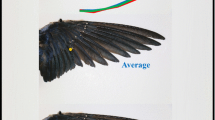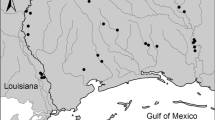Abstract
Wing morphology is known to strongly affect flight performance by affecting lift and drag during flight. Performance may consequently deteriorate during feather moult due to the creation of feather gaps in the wing. Since wing gap size may directly affect the extent of reduced flight capacity, rapid moult involving the creation of large feather gaps is expected to substantially impair flight compared with the small gaps induced by a slower moult. To examine the factors affecting wing-feather moult speed, we studied adults of nineteen resident or very short-distance migrant passerine species during their post-breeding moult using a model-selection framework following a phylogenetically controlled analysis. We examined the speed of wing-feather moult in relation to each species’ flight distance index that was estimated based on local foraging movements rather than on longer flights (e.g., migration), assessed by the Delphi technique of expert evaluation. Moult speed was also examined with respect to six morphometric variables: body mass, wing loading, the feather comprising the tip of the wing, aspect ratio, wing span, and wing area. Our results suggest that flight distance index is the most important factor determining the speed of wing-feather moult in songbirds. Species that regularly fly a shorter distance were found to moult quickly, and those that take relatively longer flights moult slowly. These results suggest that the aerodynamic cost of wing area reduction due to feather moult shapes the evolution of annual routine processes by dictating a slower moult speed (resulting in small wing gaps) for species that regularly fly long distances and consequently may be affected more substantially by large wing gaps compared with short distance flyers.



Similar content being viewed by others
References
Arnold SJ (1983) Morphology, performance and fitness. Am Zool 23:347–361
Barta Z, Houston AI, McNamara JM, Welham RK, Hedenström A, Weber TP, Feró O (2006) Annual routines of non-migratory birds: optimal moult strategies. Oikos 112:580–593
Bauchinger U, Biebach H (2006) Transition between moult and migration in a long-distance migratory passerine: organ flexibility in the African wintering area. J Ornithol 147:266–273
Bell BD (1970) Moult in the Reed Bunting—a preliminary analysis. Bird Study 17:269–281
Bensch S, Grahn M (1993) A new method for estimating individual speed of molt. Condor 95:305–315
Blair RB (1996) Land use and avian species diversity along an urban gradient. Ecol Appl 6:506–519
Burnham KP, Anderson DR (2002) Model selection and multimodel inference: a practical information-theoretic approach. Springer
Carrascal LM, Polo V (2006) Effects of wing area reduction on winter body mass and foraging behaviour in coal tits: field and aviary experiments. Anim Behav 72:663–672
Chai P (1997) Hummingbird hovering energetics during moult of primary flight feathers. J Exp Biol 200:1527–1536
Chai P, Dudley R (1999) Maximum flight performance of hummingbirds: capacities, constraints, and trade-offs. Am Nat 153:398–411
de la Hera I, Díaz JA, Pérez-Tris J, Tellería JL (2009) A comparative study of migratory behaviour and body mass as determinants of moult duration in passerines. J Avian Biol 40:461–465
de la Hera I, Schaper SV, Díaz JA, Pérez-Tris J, Bensch S, Tellería JL (2011) How much variation in the molt duration of passerines can be explained by the growth rate of tail feathers? Auk 128:321–329
Felsenstein J (1985) Phylogenies and the comparative method. Am Nat 125:1–15
Flinks H, Salewski V (2012) Quantifying the effect of feather abrasion on wing and tail lengths measurements. J Ornithol 153:1053–1065
Fogden MPL (1972) The seasonality and population dynamics of equatorial forest birds in Sarawak. Ibis 114:307–343
Francis IS, Fox AD, McCarthy JP, McKay CR (1991) Measurements and moult of the Lapland Bunting Calcarius lapponicus in West Greenland. Ring Migr 12:28–37
Freckleton RP, Harvey PH, Pagel M (2002) Phylogenetic analysis and comparative data: a test and review of evidence. Am Nat 160:712–726
Ginn HB, Melville DS (1983) Moult in birds (BTO guide 19). British Trust for Ornithology
Green GH, Summers RW (1975) Snow Bunting moult in northeast Greenland. Bird Study 22:9–17
Hall KSS, Fransson T (2000) Lesser Whitethroats under time-constraint moult more rapidly and grow shorter wing feathers. J Avian Biol 31:583–587
Hambly C, Harper EJ, Speakman JR (2004) The energetic cost of variations in wing span and wing asymmetry in the Zebra Finch Taeniopygia guttata. J Exp Biol 207:3977–3984
Haukioja E (1971) Flightlessness in some moulting passerines in Northern Europe. Ornis Fenn 48:101–116
Hedenström A (2003) Flying with holey wings. J Avian Biol 34:324–327
Hedenström A, Sunada S (1999) On the aerodynamics of moult gaps in birds. J Exp Biol 202:67–76
Holm S (1979) A simple sequentially rejective multiple test procedure. Scand J Stat 6:65–70
Jenni L, Winkler R (1994) Moult and ageing of European passerines. Academic Press, London
Jetz W, Thomas GH, Joy JB, Hartmann K, Mooers AO (2012) The global diversity of birds in space and time. Nature 491(7424):444–448
Lind J (2001) Escape flight in moulting Tree Sparrows (Passer montanus). Funct Ecol 15:29–35
Lind J, Jakobsson S (2001) Body building and concurrent mass loss: flight adaptations in Tree Sparrows. Proc R Soc London B Biol Sci 268:1915–1919
Lindström Å, Daan S, Visser GH (1994) The conflict between moult and migratory fat deposition: a photoperiodic experiment with Bluethroats. Anim Behav 48:1173–1181
Mason GJ (2010) Species differences in responses to captivity: stress, welfare and the comparative method. Trends Ecol Evol 25:713–721
Moreno E, Carrascal LM (1993) Ecomorphological patterns of aerial feeding in oscines (Passeriformes: Passeri). Biol J Linn Soc. 50:147–165
Newton I (1966) The moult of the Bullfinch Pyrrhula pyrrhula. Ibis 108:41–67
Orme D (2013) The caper package: comparative analysis of phylogenetics and evolution in R. R Package Version 5:2
Pagel M (1997) Inferring evolutionary processes from phylogenies. Zool Scr 26:331–348
Pennycuick CJ (1978) Fifteen testable predictions about bird flight. Oikos 30:165–176
Pennycuick CJ (2008) Modelling the flying bird, vol 5. Elsevier
R Development Core Team (2014) R: a language and environment for statistical computing. Vienna, Austria: R Foundation for Statistical Computing. (http://www.R-project.org)
Rayner JMV (1988) Form and function in avian flight. In: Johnston R (ed) Current ornithology, Springer US, pp 1–66
Rayner JMV, Swaddle JP (2000) Aerodynamics and behaviour of moult and take-off in birds. In: Blake RW, Domenici P (eds) Biomechanics in Animal Behaviour. Bios, London
Riggs WE (1983) The Delphi technique: an experimental evaluation. Technol Forecast Soc 23:89–94
Rohwer VG, Rohwer S (2013) How do birds adjust the time required to replace their flight feathers? Auk 130:699–707
Rohwer S, Ricklefs RE, Rohwer VG, Copple MM (2009) Allometry of the duration of flight feather molt in birds. PLoS Biol 7(6):e1000132
Rubolini D, Liker A, Garamszegi LZ, Moller AP, Saino N (2015) Using the BirdTree.org website to obtain robust phylogenies for avian comparative studies: a primer. Curr Zool (In press)
Schoener TW (2011) The newest synthesis: understanding the interplay of evolutionary and ecological dynamics. Science 331:426–429
Swaddle JP, Witter MS (1997) The effects of molt on the flight performance, body mass, and behavior of European starlings (Sturnus vulgaris): an experimental approach. Can J Zool 75:1135–1146
Swaddle JP, Williams EV, Rayner JM (1999) The effect of simulated flight feather moult on escape take-off performance in starlings. J Avian Biol 30:351–358
Tucker VA (1991) The effect of molting on the gliding performance of a Harris’ hawk (Parabuteo unicinctus). Auk 108:108–113
Williams EV, Swaddle JP (2003) Moult, flight performance and wingbeat kinematics during take-off in European starlings Sturnus vulgaris. J Avian Biol 34:371–378
Acknowledgments
We are grateful to Roi Dor and Daniel Berkowich of the Steinhardt National Collections of Natural History, Zoological Museum, Tel Aviv University for their help. We thank Eyal Shochat for his help with the Delphi technique and the fifteen birders who helped assessing bird flight distance. We also thank Daniel Weihs for his advice during the early stages of this study.
Author information
Authors and Affiliations
Corresponding author
Ethics declarations
Ethical approval
All applicable international, national, and/or institutional guidelines for the care and use of animals were followed.
Electronic supplementary material
Below is the link to the electronic supplementary material.
Rights and permissions
About this article
Cite this article
Kiat, Y., Izhaki, I. & Sapir, N. Determinants of wing-feather moult speed in songbirds. Evol Ecol 30, 783–795 (2016). https://doi.org/10.1007/s10682-016-9838-3
Received:
Accepted:
Published:
Issue Date:
DOI: https://doi.org/10.1007/s10682-016-9838-3




